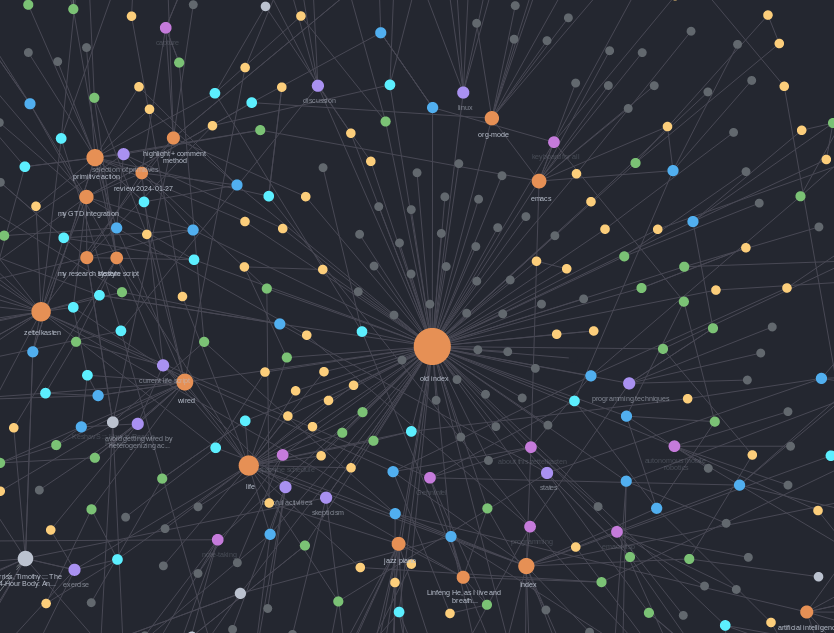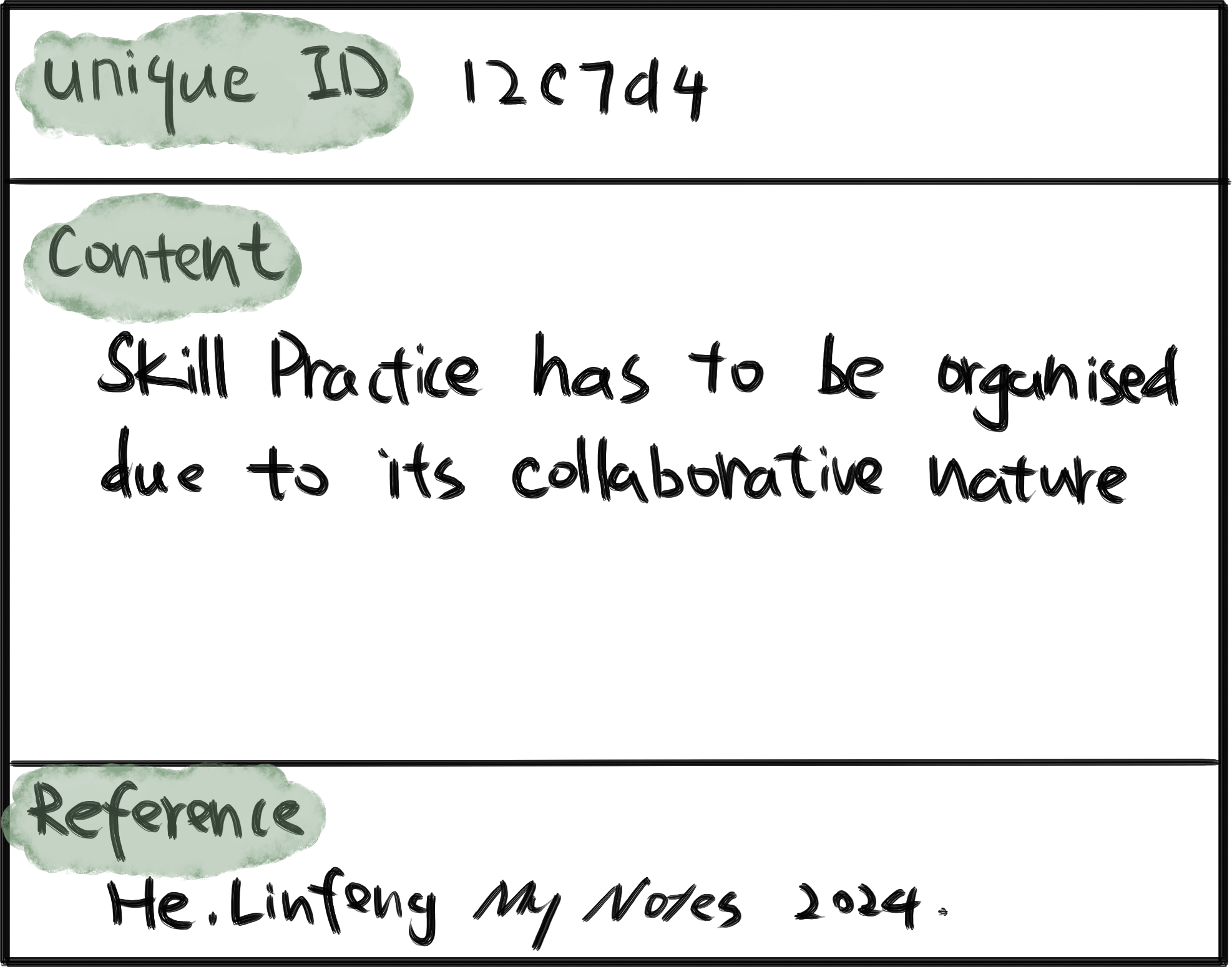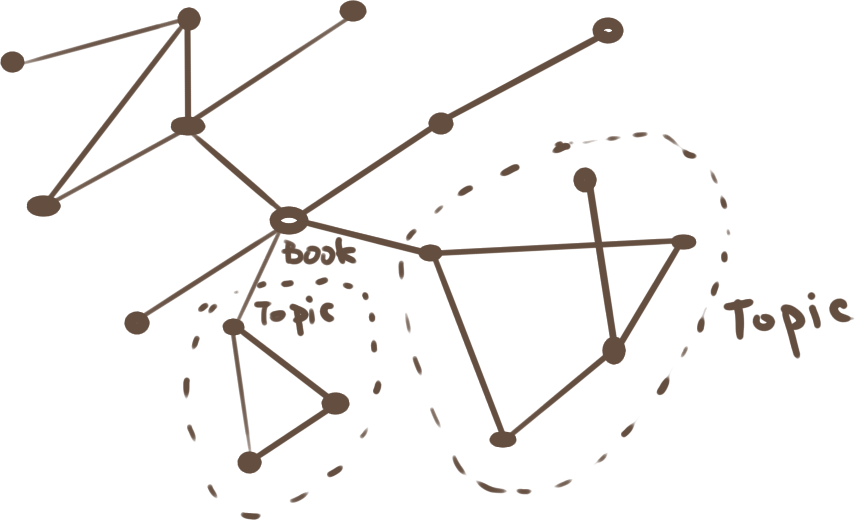zettelkasten
Table of Contents
- 1. notes on zettelkasten
- 2. tools with zettelkasten
- Backlinks
- zettel
- zettel
- zettelkasten mental model of book and articles
- wired could be good for skill practice
- tools
- small and simple works
- research
- meta
- memex
- learning strategies
- highlight + comment method
- explicitation
- discipline skill practice
- building digital garden around zettelkasten
- my GTD integration
- Gehninfel
- use computer to study
- injection

Figure 1: part of my org-roam-ui-mode graph
zettelkasten is note-taking and note management system with the following 4 properties:
- notes are managed as bag of individual zettel(instead of hierarchies)
- individual notes are atomic and short
- individual notes have unique identifier
- individual notes are connected with reference relation by quoting the unique identifier
1. notes on zettelkasten
2. tools with zettelkasten
Backlinks
zettel
basic component of zettelkasten. A zettel is formulated in the following 3 parts:

- unique ID
- used to reference a specific zettel in other zettel
- content
- an idea, a thought.
- reference
- context, or source.
A functional zettel cannot just be your whole notebook with a unique ID like “notes-in-2024”. For a zettel to be functional in a zettelkasten, it has to follow some principles:
zettel
basic component of zettelkasten. A zettel is formulated in the following 3 parts:

- unique ID
- used to reference a specific zettel in other zettel
- content
- an idea, a thought.
- reference
- context, or source.
A functional zettel cannot just be your whole notebook with a unique ID like “notes-in-2024”. For a zettel to be functional in a zettelkasten, it has to follow some principles:
zettelkasten mental model of book and articles
 Every book(or article, presentation – in fact, every serialized presentation of ideas) can be viewed as a zettelkasten, or a network of zettels.
Every book(or article, presentation – in fact, every serialized presentation of ideas) can be viewed as a zettelkasten, or a network of zettels.
In this sense, the primitives of manipulating contents of the book easily became manipulating subgraphs of the zettelkasten, which is inherent in the zettelkasten method(review).
wired could be good for skill practice
(example: batch process)
One example is batch processing. When I’m batch processing my notes, I typically do one of 4 things:
- devide it to seperate points
- merge some of the similar(or delete repeated points)
- reliterate it to zettel, and move it into my zettelkasten implementation
- reliterate it to task, and move it into my my GTD integration.
And those are it. Nothing more would be expected, and when I notice there’s something big that I would want to do(like devide index into smaller navigation notes), my capture place is right by my hand and I could just add it to a capture or a task, to be done later, as I normally would.
As such, it is fine to get wired as it can do no harm, and the enhenced focus could come in handy letting my get more notes processed.
small and simple works
A change/action performed by man would work (consistently) only if it is small and simple enough for one to qualify as a primitive action (a simple one).
Examples:
- all zettelkasten primitives are small and simple, one increment at a time
capture
1idea; write1zettel; add1link… - Ferriss, Timothy ::: The 4-Hour Body: An Uncommon Guide to Rapid Fat-Loss, Incredible Sex, and Becoming Superhuman expilicitly attributes its robustness over other fat loss methods over (p24) “the changes are either small or simple and often both”
research
Research is the process of idea generation, organization and verification/measurement. Often times, the outcome of a research task/session will be a network of ideas like in zettelkasten.
meta
This index holds links to some ideas on this zettelkasten
memex
The word is snatched from this site.
Generally, there is a type of website/document cluster, which holds one’s thinkings and experiences in entirety. They go by many names, each with some flavoured focus:
- zettelkasten
- digital garden
- second brain
- memex
- living document
- personal [assistent] wiki
highlight + comment method
A way of processing textual materials(article, book) to form an organization of ideas.
The process consist of 2 steps:
- processing the textual materials
- when had an idea: highlight the place that provokes the idea, and leave on the side comments content the idea.
- processing the highlights and comments
- discard nonsesne
- paraphrase -> more concise, accurate expression
- make visual where applicable
- organize the individual ideas into a meaningful organization
- if use zettelkasten, put those connected, better-written notes into the zettelkasten
- if with other note-taking system, use the processed ideas as material for notes.
explicitation
process of making something that used to be implicit or implied explicitly expressed.
The most intuitive approach is to observe and describe patterns of your own behaviour and/or question the cause: is it ecause of good will? are you thinking about good will explicitly when deciding to do it? are you defaulting to do it? etc.
reference and cheatsheet are explicitation of what you’d be using, and zettelkasten is explicitation of your ideas and their connections
(Example)
building digital garden around zettelkasten
Originally, zettelkasten includes only ideas that are rather scoped, or timeless, in that it focuses on ideas and universal konwledge, rather than a specific build/implementation project(how a feature of my software “dedicated session” works).
This leaves zettelkasten a solid, well-defined system of notes, while cutting out some expressiveness: you can’t have your journal, diary, project information/proposition or long-term reference like reading list of the year in it, causing the violation of one global entrance
To avoid having to have 2 or more places to store note, one could attach information not legally zettelkasten notes as extension to their zettelkasten.
my GTD integration
(process)
I spend time with my capture.org to go through my random thoughts. I’ll discard gibberish, merge related and similar, and refine organization, while capturing new thoughts I have reading them.
Those that are actionable like “I want to learn difussion model” will be paraphrase into TODO item and move to Tasks.org.
Normally I leave the thoughts in capture.org and re-process/review them until they are ready be put in zettelkasten. This had caused some problem as I now have a 3000 line mega capture.org that is hard to cover and some of them I have not seen in months(burying in the middle of the file), so I’m creating a seperate compost.org to hold those I don’t have any idea what to do with for long, so the low-hanging fruits can be picked first
Gehninfel
(Gehninfel the website)
gehninfel.xyz is personal website and zettelkasten braindump of linfeng he. The idea basically follows digital gardening, braindump and zettelkasten, which I generally think is more or less the same thing. I just write notes, put them here, and make some connections between them.
(software made easy: workflow overhead)
in workflows, when tag, id, searching, database, navigation is encountered, that almost imply necessity of using a computer: the manual labour of managing them is just absurdly high when you can have computer to do them.
zettelkasten is an example: before software solutions are available, it requires lots of space, perhaps a dedicated closet to store, and after that may not be practical to be used to larger scopes, but only per project, due to the high manual labour to find note, maintain integrity of the system etc.
injection
Injection describes the process of processing some materials that may contain pattern or knowledge into internel representation that I could use efficiently, like zettelkasten.